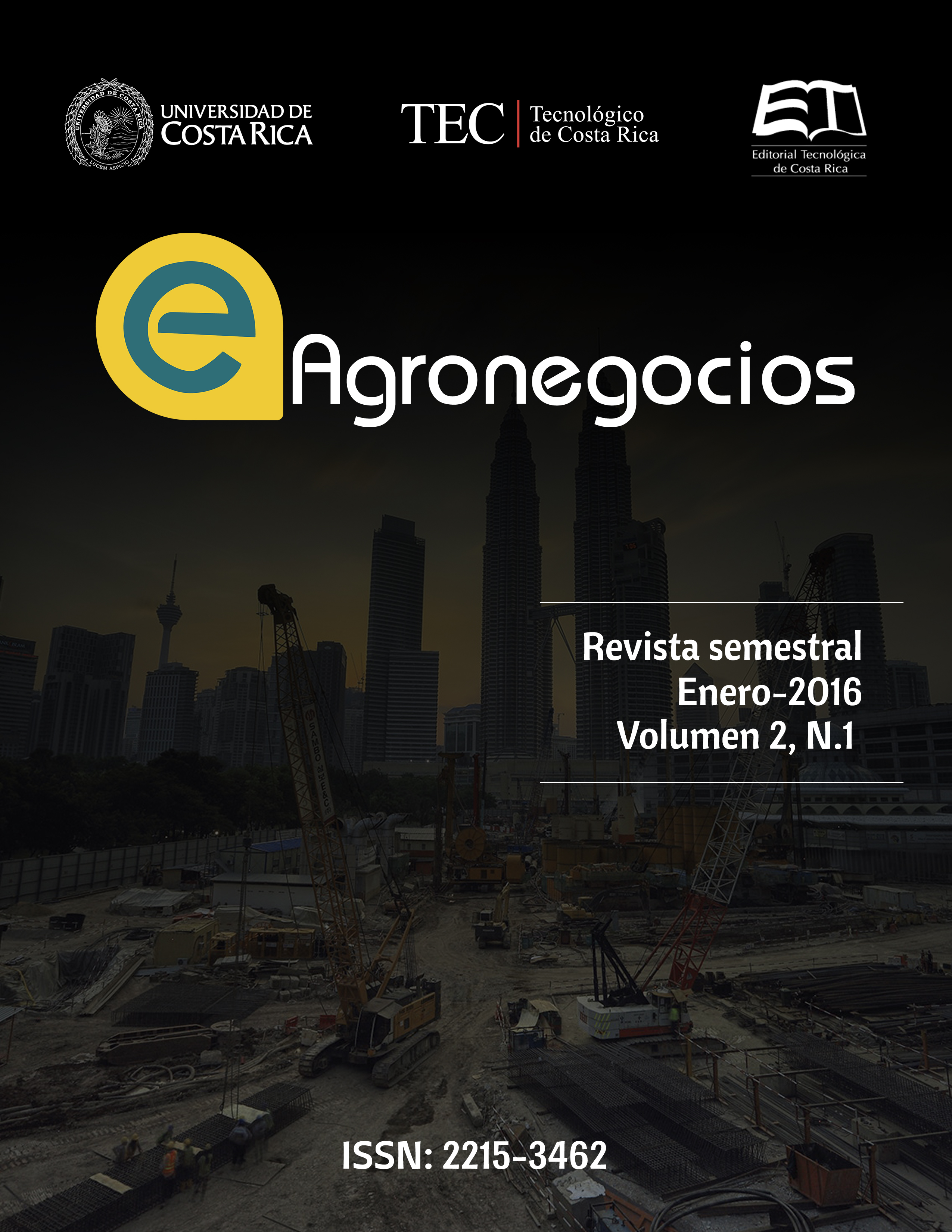Governance structures in agricultural chains: case of platinum producers, Rey Curre, Costa Rica
Main Article Content
Abstract
The main research´s objective is to identify the main plantain productive-commercial relationships, presented inside the indigenous community of Rey Curré, as well as to identify key relationships between Rey Curre´s producers and plantain intermediaries. To achieve this objective, a field research took place in 2011 and 17 surveys were conducted to determine the main producers and producers-brokers relationships. Data were analyzed using UCINET software, and then network maps were obtained which allowed identifying the most important producers, based on the number of productive-commercial relationships that each producer has. This result has extension and technology-dissemination implications, because is much more efficient to transfer technology just to "leaders", because then they will disseminate technology to all others producers which is easier than doing technological transfer one by one. Finally this research helped the Technological Institute of Costa Rica (ITCR) identifying the community leaders in order to conduct a more efficient technological transfer for a new added value product called “frozen pre-frite platain cakes”.
Article Details

This work is licensed under a Creative Commons Attribution-NonCommercial 4.0 International License.
Las personas autoras conservan los derechos de autor/a y ceden a la revista el derecho de la primera publicación y que pueda editarlo, reproducirlo, distribuirlo, exhibirlo y comunicarlo en el país y en el extranjero mediante medios impresos y electrónicos. Asimismo, las personas autoras asumen el compromiso sobre cualquier litigio o reclamación relacionada con derechos de propiedad intelectual, exonerando de responsabilidad a la Editorial Tecnológica de Costa Rica. Además, se establece que los autores pueden realizar otros acuerdos contractuales independientes y adicionales para la distribución no exclusiva de la versión del artículo publicado en esta revista (p. ej., incluirlo en un repositorio institucional o publicarlo en un libro) siempre que indiquen claramente que el trabajo se publicó por primera vez en esta revista.
References
Bourgeois, R., & Herrera, D. (1999) . Enfoque Participativo para el Desarrollo de la Competitividad de los Sistemas Agroalimentarios. San José, Costa Rica: IICA.
Burch, D., & Lawrence, G. (2007). Supermarkets and agri-food supply chains: transformations in the production and consumption of foods. En D. Burch, & G. Lawrence, Supermarkets and agri- food supply chains: transformations in the production and consumption of foods (pág. 330pp). Cheltenham, England.
Coase, R. (1937). The Nature of the Firm. Economica, 386-405.
CREST. (2012). The Case for Responsible Travel: Trends and Statistics. http://www.responsibletravel.org/news/Fact_sheets/Crest_RTI_TrendStats_print_1_ 4%20(3).pdf: Standford University.
Granovetter, M. (2005). The Impact of Social Structure on Economic Outcomes. Journal of Economic Perspectives, 33–50.
Haynes, D. (2000). Transaction-Costs Economics and the Evoling Structure of Agricultural Production. E-Commerce in Agribusiness. Edited by Schmitz, T.G, C.B Moss, A Schmitz, A. Kagan and B. Babcock., Florida, Florida Science Source, Inc.
Hitt, M. (2012). Relevance of Strategic Management Theory and Research for Supply Chain Management. Texas A&M. Research Paper. , 9-13.
Humphrey, J., & Schmitz, H. (2000). Governance and Upgrading: linking industrial cluster and global value chain research. IDS Working Paper 120, Institute of Development Studies.
Kherallah, M., & Kirsten, J. (2001). The New Institutional Economics: Applications for Agricultural Policy Research in Developing Countries. Washington DC: International Food Policy Research Institute.
Mount, P. (2011). Growing local food: scale and local food systems governance. Agricultural and Human Values, 107-121.
Newton, P., Agrawal, A., & Wollenberg, L. (2013). Enhancing the sustainability of commodity supply chains in tropical forest and agricultural landscapes. Global Environmental Change, 1761–1772.
OECD. (2015). FAO-OECD Guidance for Responsible. Obtenido de http://www.oecd.org/daf/inv/mne/FAO-OECD-guidance-responsible-agricutural-supply-chains.pdf
Pike, A., Rodríguez-Pose, A., & Tomaney, J. (2006). Local and Regional Development. New York: Routledge.
Simon, H. (1958). Models of Man. Journal of the American Statistical Association, 600-603.
Stoian, D., & Gotret, M. V. (2011). Ejes Temáticos para el Fortalecimiento de Cadenas (CATIE) . Cadenas Productivas y Desarrollo Económico Rural en Latinoamérica, 125-149.
UNEP. (2011). Towards a Green Economy. Pathways to Sustainable Development and Poverty Erradication. Retrieved from http://www.unep.org/greeneconomy/Portals/88/documents/ger/ger_final_dec_2011/ Green%20EconomyReport_Final_Dec2011.pdf
Viales, R. (2010). La región como construcción social, espacial, política, histórica y subjetiva. Hacia un modelo conceptual/relacional de historia regional en América Latina . Geopolitica, 157-172.
Wiliamson, O. (1979). Transaction-Cost Economics: The Governance of Contractual Relations . Journal of Law and Economics, 233-261.
Williamson, O. (1991). Comparative Economic Organization: The Analysis of Discrete Structural Alternatives. Administrative Science Quarterly, 269-296.
World Bank. (2008). Agriculture for Development. World Development Report. Washington DC: The International Bank for Reconstruction and Development / The World Bank.

